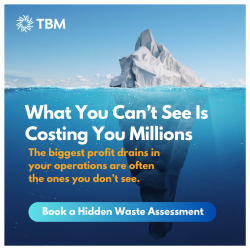In the dynamic world of pharmaceutical manufacturing, operational efficiency, precision, and adaptability are paramount for achieving success.
I recently had the pleasure of partnering with a major U.S. pharmaceutical manufacturer who, despite a healthy increase in revenue, profits remained stagnant. The organization grappled with ineffective decision-making, recurring issues, and a lack of continuous improvement efforts. The absence of strategic enhancements and empowerment led to an environment of blame-shifting, causing delays and suboptimal performance.
This is a similar story we see at many companies. While revenues may be on the up-and-up there are challenges behind the scenes that can quickly hamper long-term success both financially and operationally. I am sharing my experience about a company to help manufacturers large and small to understand the potential to grow the bottom and top line towards profitable growth.
Through meticulous planning, comprehensive strategies, and unwavering dedication to change, this pharmaceutical company revamped its management system, resulting in improved productivity, elimination of Back Log with improved On time Delivery , Inventory reduction in a relatively short period of time.
But first, what is a Management System?
A Management System is a systemic approach and process rigor for daily control, focused on the shop floor as well as up to the highest levels of the organization. It highlights problems and leverages those problems for improvement and creates a robust structure, metrics and capability to perform.
You might not recognize it as such, but every company has a business management system. At most organizations, there’s a lot of room for improvement. An effective Management System is a deliberately integrated set of management processes and tools that help align the company strategy and annual objectives with daily actions, monitor performance and trigger corrective actions when metric targets are not met. It guides and empowers managers, supervisors and team leaders to drive process improvements every day, while sustaining any gains that are made. At TBM, our lean consultants with deep manufacturing operations experience have designed and implemented the TBM Management System to bring operational support for pharmaceutical manufacturing companies across the globe.
For pharmaceutical companies in a highly regulated environment, it is paramount to ensure products are manufactured according to specification to ensure they are safe and effective. A management system creates a process rigor and cultural discipline for quality which improves the speed and cost of production and detection of irregularities before distribution, thus improving customer satisfaction and company profitability.
This was precisely my client’s focus when making the decision to revamp their management system which increased productivity and on-time delivery, while reducing change-over times, inventory and backlogs.
Here is how they took operational excellence to the next level.
Uncovering Systemic Inefficiencies Hindering Progress
Recognizing the imperative for transformative change, the pharmaceutical manufacturer engaged in Kaizen events where we uncovered systemic process inefficiencies that were hindering progress and created solutions for improvement. Where these short-term solutions were necessary, the outcome of the Kaizen events made it clear to senior leadership that change needed to be long-term. Upon their request, we conducted a comprehensive assessment of operations which included the implementation of TBM’s Management System approach to address the identified challenges, drive improvements, and accelerate operational and financial results they were looking for.
With collaboration between the pharmaceutical operation team and our team, we revealed several critical challenges:
- Incomplete Operational Insights: Existing Tier 1 and Tier 2 board reviews primarily centered on production output, lacking a comprehensive view of operations.
- Flawed Metric Tracking: Efforts to implement Hour X Hour (Hr X Hr) reporting faced resistance, resulting in ineffective metric tracking and accountability gaps.
- Limited Problem-Solving: The absence of Hr X Hr information impeded problem identification and resolution.
- Resource Strain: Frequent Tier 1 board meetings consumed excessive management resources and line supervision time.
- Accountability Gap: A lack of support group accountability and unresolved actions led to workforce frustration.
- Visibility Constraints: Inadequate tracking of key performance metrics hindered the evaluation of countermeasure impacts.
- Fragmented Meetings: Senior management meetings lacked engagement, hindering alignment on key improvement metrics.
- Centralized Decision-Making: Decision-making authority centralized at the VP and Department manager levels led to delays in actions due to a lack of empowerment.
- Overtime Challenges: Excessive overtime resulted in diminished task completion efficiency for support groups.
A Comprehensive Blueprint: Proposed Plan of Activities and Processes
Fueled by data insights and expertise, the pharmaceutical manufacturer embarked on a transformative journey guided by a clear plan of action:
- Strategic Objectives: A definitive Strategy Deployment process was established, aligning with key business objectives. Annual Improvement Priorities were identified, with dedicated teams accountable for their achievement.
- Hr X Hr Tracking: Hr X Hr tracking was adopted to assess target attainment and capture reasons for shortfalls. A Pareto analysis identified key issues in Safety, Quality, Delivery, and Cost.
- Efficient Change-Overs: Efficient changeovers were imperative for high-speed, multi-product lines. Standard work and critical setup parameters were established, resulting in a substantial reduction of changeover times.
- Structured Meetings: Meeting structures and metrics for Tier 1, Tier 2, and Tier 3 were introduced, facilitating issue escalation and resolution.
- Problem-Solving Tools: Comprehensive training in problem-solving tools empowered employees across all levels, from basic techniques to advanced methodologies.
- Steering Committee: A Steering Committee, comprising senior management and directors, ensured resource allocation, addressed obstacles, and provided coaching and mentoring.
- Data Collection and Reporting: Robust data collection and reporting mechanisms were established to optimize efficiency during Tier meetings.
- Leader Standard Work: Leader Standard Work was introduced to reduce firefighting and enhance auditing, training, problem-solving, and continuous improvement efforts.
A Triumph of Transformation: Results and Outcomes
The pharmaceutical manufacturer’s unwavering commitment to change and operational excellence, combined with the pharma expertise of the TBM consultants, yielded remarkable results:
- Heightened Productivity: A 17% surge in productivity was achieved, exemplified by a reduction in Direct Labor Cost per unit.
- Streamlined Changeovers: Changeover times were significantly slashed by 60% to 75%.
- Timely Deliveries: On-time delivery rates soared from 85% to an impressive 90%.
- Elimination of Backlog: Within a mere six months, a 100% backlog reduction was accomplished.
- Optimized Inventory: A substantial 13% reduction in inventory was realized, leading to enhanced resource allocation.
Elevating the True and Hidden Potential
The collaboration between the pharmaceutical manufacturer and a new perspective and knowledge from outside consultation illuminated the true and hidden potential of the company. The approach of the management system stands as a testament to the potential of strategic planning, comprehensive change, and continuous improvement. By addressing systemic challenges and implementing a robust management system, the company achieved unprecedented growth and profitability. This remarkable journey serves as an inspiring reminder of the power of partnership, dedication, and visionary leadership in propelling manufacturing excellence and shaping a brighter future for the pharmaceutical industry.
Meet the Expert
Nero Haralalka
Director, US Consulting
Nero Haralalka has extensive experience in lean manufacturing and back office process improvement. He is one of our leading subject matter experts in statistical problem solving.







